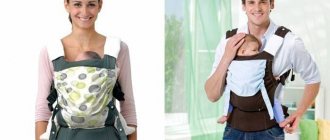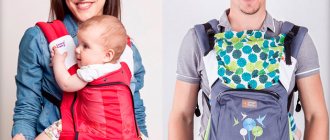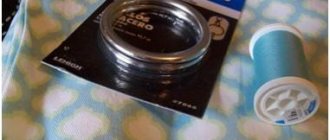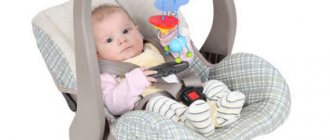A sling jacket is a jacket under which you can carry a child in a backpack or sling. The kit includes a sling insert that fastens and increases the volume so that the child fits comfortably under the jacket. Almost all babywearing jackets are also jackets for pregnant women. Usually the set includes a second insert - for a large belly. Or the design of the jacket is such that it fastens on any stomach, without turning mom into a shapeless bun. Without exception, all sling jackets can be used simply as a jacket - without any inserts.
A babywearing jacket is better than just a maternity jacket
Many pregnant women, for various reasons, do not plan to carry their baby in backpacks and slings. Our experience shows that attitudes towards slings and backpacks change after the birth of a child. Someone, as planned, makes do with a stroller. Someone becomes a fan of baby carriers and an active baby carrier. It often happens that the first child felt great in a stroller, but the second one just doesn’t want to put up with such a means of transportation. Or with the first child, the mother could afford leisurely walks, but with the second, life becomes more fussy. I need to pick up my eldest from school, I need to go to the store with the baby. Then carrying becomes a necessity. It is better to foresee such a development of events in advance and take a jacket “with reserve”. This is cheaper than first buying a jacket only for pregnant women, and then going for another one - this time for carrying a child.
how to tie a sling scarf for a newborn
A sling is an ancient device for carrying a small child. One of the oldest images of a patchwork sling for carrying children dates back to the second millennium BC. Many nationalities have their own ethnic slings, and modern means of carrying children have their origins in the ancient traditions of babywearing. There are four most popular and common types of slings: ring sling, pocket sling, scarf sling, and May sling. You can add to this series a physiological backpack, which, under certain conditions, ensures the same position of the child as in a sling.
Ring sling
This is one of the most popular types of slings today. The prototype of a ring sling is an ordinary scarf or shawl, used to carry children in various places around the world: Africa, Sweden, Russia, Cambodia, India and other countries. The honor of inventing the ring sling rightfully belongs to Dr. Rayner Garner. It was he who came up with it for his daughter Fonda, born in Kaneohe, Hawaii in 1981. At first, Sachi, Rainer's wife, used a soft woolen scarf tied in a knot, but it was not very comfortable. Then Rainer came up with the idea of threading the fabric through wooden rings so that the sling could be adjusted. The idea turned out to be successful and aroused great interest among other parents. Sachy and Rainer organized the first production of ring slings, and then the idea was picked up by William and Martha Sears and spread it throughout America, Europe and Russia. Design. A modern sling with rings is a strip of fabric about two meters long and 60-70 cm wide. Rings are sewn (or simply threaded) through one end of the fabric, and the other end of the sling is tucked into the rings so that its length can be adjusted. On the Internet you can often find the abbreviation SSK - it means “ring sling”. The most optimal material for a sling with rings (and perhaps any sling) is the so-called “scarf” fabric, that is, the fabric used for scarf slings (twill and jacquard weave). It distributes the load better, is beautiful, and during use it only gets better - softer and “more cuddly.” In addition to it, other natural fabrics are used - satin, silk, linen, calico, denim, but they are more demanding to adjust. Provisions. A baby can be carried in a sling with rings from birth, both horizontally and vertically (in the fetal and “frog” position). It can be worn on the hip and on the back from the moment the baby holds his head and you are confident that you can position him correctly, but this is not the most comfortable sling for back positions.
Pros: A sling with rings is very “mobile”, it’s easy to change the baby’s position on the go, you can quietly pull out a sleeping baby by simply loosening the rings. You can quickly get your child in and out quickly. The sling is ideal for home use with a child of any age, as well as for wearing during the newborn period and for children over 1 year old when they get tired on walks. The tail of the sling is convenient for hiding from prying eyes while feeding in public places. Cons: The load is distributed only on one shoulder and back, so you need to alternate your shoulders regularly. This is important for the uniform development of the child’s muscle corset and the mother’s posture.
Sling pocket
The sling pocket with its characteristic “smile” was invented in 1986 in Hawaii by Hygeia Halfmoon, author of the book Primal Mothering in a Modern World. Until that time, there were ordinary tube slings, which were simply a strip of fabric sewn into a ring. The “smile” invented by Higea significantly improved the functional properties of this sling. However, the fabric from which they were made, although suitable for the hot Hawaiian climate, turned out to be thin and uncomfortable for slings from other countries. In 1992, Higeya showed how to sew pocket slings from the American company NewNativeBaby, and soon NewNative pocket slings appeared in more suitable fabrics. Then the production was picked up and other slings quickly gained popularity among baby carriers. Design. The sling pocket is a ring of fabric with an arc-shaped dart - a “smile” on one side. Thanks to it, a cozy pocket is formed in which the child is located. Due to the design features, the baby is attracted to the mother better than in a tube sling. Provisions. The sling-pocket can be worn from birth in horizontal, vertical and semi-vertical positions. Wear the baby on the hip and back from the moment when the baby holds his head and the mother is confident that she can position the baby correctly. Pros. This is the simplest sling: put it on and go :). It's easy to get your baby in and out, and you don't have to adjust anything. Pocket is the most compact type of sling that will fit even into a small handbag. Minuses. The lack of adjustment is both a plus and a minus: for different seasons and different family members (if dad is also carrying a child), you will have to buy different slings. In addition, when buying a pocket sling, you need to try it on, otherwise it’s easy to make a mistake with the size. And this is critical for the correct placement of the child. Modern manufacturers have begun producing adjustable sling pockets, the size of which varies depending on the mother’s needs. The load in the sling pocket is distributed on one shoulder and the back; shoulders must be alternated regularly. Overall, the pocket is less versatile than a ring sling.
May-sling.
The traditional Mai-sling (mei-tai) came to us from China. It is a square (or close to square) piece of fabric with four parallel straps of equal length. The straps are narrow, not padded, and quite short: traditional mais are not designed for the average Western European figure, because... Chinese women tend to be smaller and slimmer. In the 1960s, one of the variations of mei tai became popular in Australia, and in 2003 it appeared in America and immediately fell in love with American women. The sling was improved: the back and front straps were lengthened for more convenient tying, and filler appeared in the straps. The baby was “hugged” and did not roll over onto his side; not all baby slings can provide adequate support for a newborn baby. The horizontal position in the May Sling is not very comfortable. Pros: My sling distributes the load on two shoulders and the back at once, thereby making carrying a child more comfortable. This is a fairly simple sling to learn. My-sling made of soft plastic fabric allows you to adjust the height and width of the back, adjusting it to a specific child. Cons: Lack of a comfortable horizontal position. Not all May-slings are able to adapt to the child.
Sling scarf
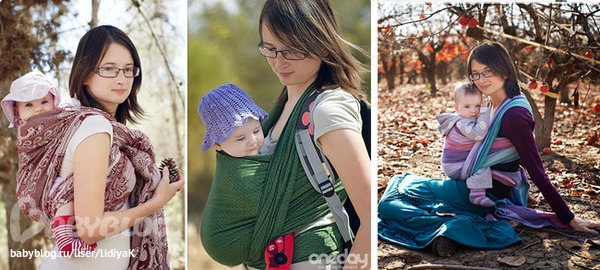
The honor of inventing the long sling-scarf belongs to Erica Hoffman, the founder of one of the world's largest sling manufacturing companies - Didymos. The story of Didymos begins in 1971 with two twins – Lisa and Tina (didymos means “twins” in Greek). Erica had a sling from Central America, but because it seemed too exotic to her, she initially hid it in her chest of drawers. But one day, having tried several methods of tying, she found the most suitable one and went for a walk. In no time, they became the number one topic of discussion among the villagers, and although not all comments about them were positive, the twins convinced Erica that she had made the right choice. Their faces lit up with smiles as soon as they saw the sling, and Erica, in turn, again and again experienced the joy of physical contact with either Lisa or Tina. Carrying in a sling could have remained one of the pleasant episodes in Erica’s family life if the magazines “Heilbronner Stimme” and “Stern” had not published an article about them. Erica received requests from all over Germany to send her the same sling, and in 1972 she opened her own production. Now there are a huge variety of different brands of scarf slings: they are divided into knitted and woven (twill and jacquard weave), there are thinner and denser ones, more “hugging” and soft, and more load-bearing ones. Knitted scarves are more suitable for newborns: due to the stretching of the fabric, they fit the baby softer and more comfortably, but due to the same stretching, they are less predictable and hold the load much worse. After 6-6.5 kg, the knitted scarf will need to be re-tightened regularly. Woven (non-stretch) scarves are ideal for kids of any age. For babies, they will be good from soft cotton or with silk and babmyk in the composition, which give the sling special tenderness, silkiness and coolness. The ability to precisely adjust the winding in any position (both vertical and horizontal) makes the scarf the most versatile sling. Scarf slings are a passion. You will almost never meet collectors of May-slings or slings with rings (although there are the latter), but there are quite a lot of sling scarf “tycoons” in Russia, and not only in Russia. How could it be otherwise? :) After all, a sling is far from just a means of transporting a baby, but a stylish item of clothing. It easily matches with completely different clothes: from classic business and long flowing skirts to banal jeans and trousers. Photo by Ira Aviv, Israel Construction A sling scarf is a long strip of fabric, usually three to six meters long and 45-70 cm wide. The ends of the scarf can be rounded, beveled or fringed. Scarf slings come in different lengths. It depends on the way you want to carry your baby and your size. The most “running” is 4.2-4.7m Position. In a sling-scarf you can carry babies from birth in horizontal, vertical and semi-vertical positions. Wear the baby on the hip and back from the moment when the baby holds his head on his own and the mother is confident that she can position the baby correctly or she has the opportunity to use someone’s help (important for back winding). The end of wearing is regulated only by the physical capabilities of the mother and the desire of the baby. Pros. This is the most versatile sling for a child of any age. The sling scarf can be worn either on one shoulder or on two shoulders; the load is evenly distributed on the mother's back and shoulders. If the most comfortable load distribution is important to you, this is your sling. A scarf makes it possible to vary the load - support your back like a corset, transfer part of the load to the waist and hips, or vice versa, the main part to the shoulders and back. Long walks, guests, hikes - you can handle everything! There are dozens of different winding methods, and nothing stops you from coming up with your own. However, you can limit yourself to one or two and successfully carry your baby from the first days of life until the end of babywearing. Easily matches with different clothes. A huge variety of colors and compositions makes it possible to have a sling to suit the most demanding tastes. At the end of the sling age, the scarf can be used as a hammock, including for an adult: branded scarves can withstand such loads perfectly. Minuses. Some mothers find the sling scarf difficult to master. However, it is not! Just a little practice is enough, and in just a few seconds you can wrap a scarf around yourself, although, of course, careful and meticulous winding will take you a little longer. It is inconvenient to rewind a sling scarf on the street and in public spaces with dirty floors, so if you still have to, use benches, pockets and generally any surfaces where you can attach the ends of the scarf while winding. Physiological (ergonomic) backpack
Design A physiological backpack is somewhat similar to a May-sling, but has a number of design features. An important distinguishing feature is the rigid belt, which takes most of the load on itself, distributing it to the mother’s hips (or waist), depending on how it is worn. It should not crumple into an accordion, much less be soft (sintepon or foam rubber). The straps of the backpack are wide and dense, depending on the model of the backpack, they can be placed either parallel or crosswise, or both ways - as is convenient for the mother. The back, unlike the “kangaroo”, is soft and allows you to tightly pull the baby’s back in all its parts. The width of the back of the backpack is usually fixed. It is important that at least the waist fastex has a safety elastic in case of breakage or accidental unfastening. Read more about the differences between a physiological backpack and a “kangaroo” Provision. The most common position in a physiological backpack is vertical. As a rule, a child begins to be placed in a backpack from 4-5 months (depending on the model of the backpack and the weight of the child), paying attention to the fact that he completely “chooses” the volume of the backpack with his body and can spread his legs. Read more. The child can be carried in front or behind. On the hip it is technically possible, but inconvenient. There are a number of backpacks marketed as backpacks for children from birth (for example, Manduka, Bianca, Koalababy, Ergo). For the ergo (and its copycat backpacks), manufacturers offer a special soft mattress for carrying newborns, which allows you to place the baby in a horizontal or semi-vertical position. This method of carrying does not guarantee the physiologically correct positioning of the child, and is not very comfortable due to the asymmetrical distribution of the load and the impossibility of feeding unnoticed. In addition, it may be too hot for the baby. The design of such backpacks as Manduka, Bianka, Coalababy assumes only a vertical position of the baby - first with the legs inside in the “frog” position, then as they grow – with the legs outside. However, the lack of uniform support for all parts of the spine and neck, excessive compression and straightening of the spinal arch, and the non-physiological position of the legs - the most common problems in backpacks - do not provide grounds for their safe use with children under 4-6 months. Please note that a backpack does not provide the same soft and precise fit to the back of a newborn and baby as a scarf or ring sling does. It cuddles the baby, but due to the fact that it does not have the possibility of fine adjustment, the backpack does not provide that ideal support for the curve of the baby’s back, like woven slings, and in addition, it does not make it possible to adjust the width of the legs to a comfortable distance for the baby. Therefore, despite the fact that the backpack may be positioned by the manufacturer as a backpack from 2 months or from birth, this is not the best choice for parents who care about the health of the baby. You can read more about wearing and selecting backpacks here. Pros. The backpack is very easy to put on and many dads “get it.” “This is clear to us!” - they say :). Zip it up and go! The load is evenly distributed on the parent's back, shoulders and hips. The backpack is very convenient when going somewhere to public places (clinics, etc.), where you need to quickly take the baby out and put him back in again, without sweeping the floor with the tails of the sling. Minuses. The main disadvantage of a backpack is the need for the child to achieve certain parameters: weight, body volume and leg length. The backpack needs to be measured. They all “sit” differently on the mother and fit the baby differently. It is extremely important for a non-sitting child to make sure that his position is physiological (see criteria at the bottom of the article). To carry a backpack comfortably, you need to “customize” it for yourself, stretch the sling to the required length, find a convenient place for carabiners (if they are not sewn into the back of the backpack), etc. This may take some time. When carrying babies vertically, a backpack does not provide the opportunity to finely adjust the tension of the fabric as scarf slings and slings with rings, which more gently and accurately allow you to maintain the desired curve of the baby's back. A backpack restricts the movement of the child in it more than, for example, an SSC or a scarf. Not all children like it. Therefore, unfortunately, the backpack cannot claim versatility.
Why do you need a maternity jacket?
There is a great temptation to save money and find a regular jacket four sizes larger from friends. Dad's outerwear is often used. The savings are obvious. But a jacket of size 50 doesn’t look very good on a mother who is used to wearing size 42, to put it mildly. And the belly, by the way, will not be noticeable - this is really important for those who travel on public transport. The comfort of the “dad’s jacket” is also questionable. Long sleeves and a wide hem are especially annoying - they will blow out.

The maternity jacket is made to size. And when choosing, you need to focus on your “pre-pregnancy” size. Of course, it seems to mom that she has become immense. But shoulders, arm length and height during pregnancy, fortunately, do not increase.
Options for placing a child in a sling
How to put on a sling, how to position a child in it? There are three options, regardless of the type of fabric carrier:
- on the stomach;
- on the thigh;
- on the back.
In slings with rings, you can also place the baby in the “cradle” position - for newborns this position in the sling is most suitable. Children older than six months can already be seated vertically.

Why carry a child under a jacket?
It's more convenient. Under the babywearing jacket the child is dressed in home clothes. This makes it very easy to go outside and significantly reduces the time and nerves of dressing your baby. Mom is always sure that the child is not cold, since she warms him with her body. The child does not breathe frosty air, even if it is very cold. In any room you can simply unbutton, and both will not be hot. No need to sweat or fuss with undressing and putting on the carrier. This is true for a variety of situations: in a clinic, in a school or kindergarten with a senior, in a store and shopping center.
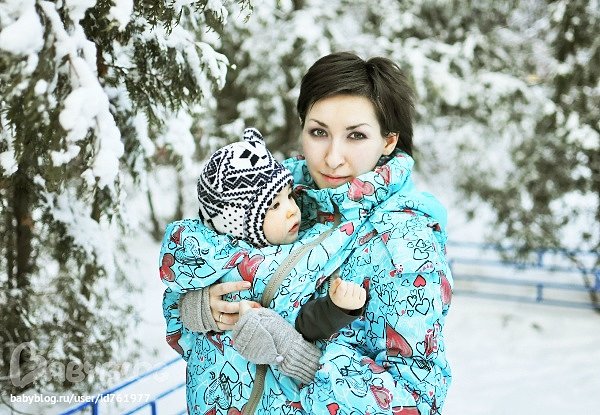
Diva Outerwear wool baby wrap
The babywearing wrap consists of a large “pocket” with which you cover the baby, and straps for attaching the wrap to the adult. At the same time, the STRAPS ARE ADJUSTABLE IN LENGTH , so the cape will suit parents with different builds.
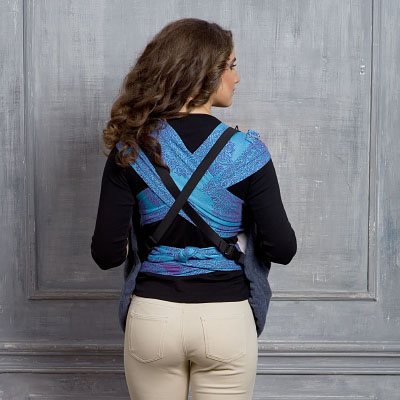
FASTEX CLASPES , with which the straps are attached, are simple and easy to use. With their help, the cape is easy to put on even with a child asleep in the sling.
The NATURAL SHEEP WOOL composition provides excellent warmth and will protect the child from wind and cold, and will not cause allergies.
On the outside of the cape there is a LARGE POCKET almost the entire width of the back. It warms an adult's hands during a walk and covers the child's back with an additional layer of woolen fabric.
A CHILD'S HOOD will protect your baby from the wind. It also rolls up into a roller, which can be attached to a special button - it makes an excellent HEAD REST.
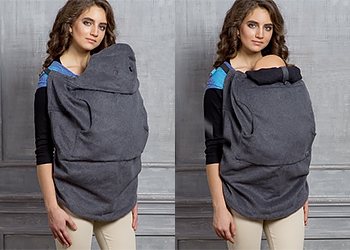
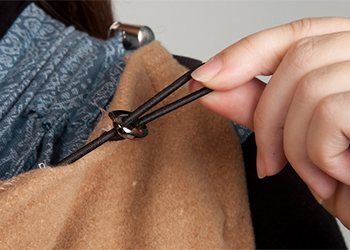
an ELastic band along the edge of the cape that will protect the baby's legs from blowing. There are fasteners on the sides of the wrap that help you adjust the wrap for both very small children and older children up to 86 cm in height. You can also use the baby wrap for children taller than this height. In this case, the feet will already be outside, and not hidden inside, which is logical: after all, such large children, as a rule, already have street shoes on their feet.
Doctors' opinions on slings
Both domestic and foreign doctors and psychologists continue to study the effect of slings of various models on a child’s health. For example, traumatologist D.N. Filippov claims that such fabric baby carriers do not cause any harm to the development of the baby’s musculoskeletal system. Moreover, this physiological position in which the child is in a sling helps prevent diseases of the hip joints and spine.
Pediatrician Rochelle Cases shares a similar opinion, but clarifies that slings are safe for the health of a newborn only if they are chosen and used correctly.
Many psychologists share a similar opinion with pediatricians. Experts say that carrying a baby using a patchwork carrier allows you to maintain the emotional comfort of the baby and promotes the unity of mother and child.
